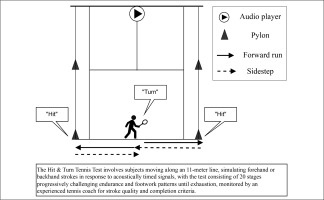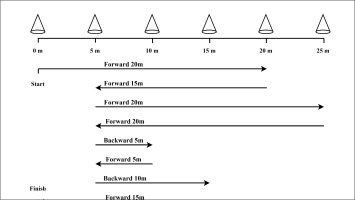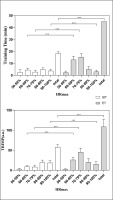INTRODUCTION
Tennis is a sport requiring both explosive, high-intensity efforts (e.g., acceleration or reacceleration for sprinting, and deceleration for stopping and turning) and sustained bouts of lower-intensity activity (e.g., rallies and endurance-based movements) [1, 2]. To cope with the high level of physical, technical, and tactical demands of performance, competitive tennis players need a combination of fitness qualities, such as speed, agility, repeated-sprint ability (RSA), and power, combined with well-developed aerobic fitness [3]. Typical tennis competitions have average points lasting less than 10 s, with rest periods of approximately 20 s between points and 90 s after every second game whereas, the total match time can be lasted for hours (occasionally more than 5 hours) [1] and therefore, it can also be highly challenging to the metabolic systems for competitive players.
Despite the high demand for explosive movements in a tennis serve, ground stroke, and repeated sprints, it has been shown that tennis is aerobic-dominant with about 70% aerobic and 30% anaerobic energy supply during the game [4]. In addition, high-intensity tennis drills heavily rely on both the phosphagen and glycolytic energy systems for rapid fuel supply [5]. As oxidative phosphorylation is one of the key processes for the resynthesis of phosphocreatine, athletes with good aerobic capacity can demonstrate better phosphagen reserve [6], and are more efficient in removing metabolic by-products for facilitating recovery and the maintenance of high performance in subsequent sets and games [7].
Traditionally, continuous endurance training (ET) such as moderate to high-intensity long-distance running (e.g. at 75–85% of lactate threshold velocity or 70% of maximal oxygen uptake [
SIT involves short bursts of exercise with “all out” effort (i.e., at a power output or velocity above
In spite of the aforementioned potential benefits, the application of SIT in intermittent sports like tennis, particularly among elite athletes remains relatively unexplored. Existing research on SIT has primarily investigated endurance sports, such as cycling and running performance in triathlon [19], and has recruited general populations rather than elite athletes. Prior systematic reviews and meta-analyses have made efforts to examine the impact of cycle ergometer-based SIT on aerobic capacity and sprint power [14]. However, these synthesis studies mostly incorporated a significantly limited amount of data (less than 10%) from competitive athletes. Moreover, the populations involved in these studies were predominantly composed of sedentary individuals or those engaged in only moderate-frequency recreational activities [14], suggesting a limited application of findings to the elite populations. In addition, previous research has primarily relied on laboratory-based equipment such as cycle ergometers and treadmills [20]. However, these modes of training and testing may not fully replicate the specific demands and conditions of tennis. Moreover, using such equipment can be both expensive and time-consuming, particularly when multiple athletes are involved in the training at the same time [21]. Given the constraints of time and resources that are often associated with high-performance training, these interventions may be deemed impractical for some athletes and coaches. Furthermore, if training activities replicate the motor patterns, contraction types, and force patterns utilized during competitive performance, there is a higher likelihood of achieving enhanced training transfer to on-field performance [22]. In contrast to the lack of specificity in ergometer-based protocols, court-based interventions should theoretically better develop the physical, physiological, and metabolic indices required for field-based sports including tennis [23].
To fill the research gaps, this study aimed to explore the effect of a 6-week court-based SIT on improving aerobic capacity and repeated sprinting ability for competitive tennis players, utilizing both laboratory and tennis-specific field tests. It was hypothesized that SIT would induce a greater improvement in these parameters compared with traditional continuous-based ET. For digging into the principle of the application of SIT boosting the transformation from training to on-field performance, the mechanism of oxygen uptake and transport should also be taken into account.
MATERIALS AND METHODS
Subjects
Sixteen competitive collegiate tennis players volunteered to participate in the study during the preparatory season. Based on the requirement for maintaining consistency among the characteristics of the participants and the shortage of female athletes from the tennis academy, the study chose to focus exclusively on male tennis players. The sample size of the study was determined to use a priori power analysis (utilizing G*Power version 3.1.9.7, University of Dusseldorf). The analysis considered several parameters, including the effect size (ES) index (0.40) assuming a large partial eta-squared (.14), α error probability (.05), power (0.90), number of groups (2) and measurements (3), and correlation among repeated measurements (.5). Considering these parameters, the power analysis indicated that a sample size of 16 subjects was appropriate for the study [13].
The participants, who were all right-handed, had a weekly training volume of 20 hours consisting of 3 hours of technical and tactical tennis practice and 1 hour of physical conditioning on weekdays. The inclusion criteria for participants are as follows: all subjects were in good health and had no severe injuries during the last six months before the study and had a minimum of 4 years of systematic tennis training experience. Participants were fully informed of the experimental procedures, benefits, and risks associated with the study before giving their written informed consent to participate. The tests were conducted at least 48 hours after a competitive match or heavy training session. The subjects participated in all the training sessions as well as pre-and post-tests. The study was approved by the Research Ethics Committee of Beijing Sport University (Approval number: 2023210H) and all procedures were conducted following the Declaration of Helsinki.
Design
A longitudinal and randomized controlled experimental design was used to investigate the effect of a 6-week court-based SIT intervention on the aerobic ability and performance parameters of tennis players in 2023. A 2-group, repeated measures (pre-test and post-test) design was used. Subjects were randomly allocated into the SIT and endurance training (ET) groups (SIT: n = 8, ET: n = 8) using stratified block randomization. The demographic data of the subjects are presented in Table 1. No significant differences were observed among the groups in terms of competition level, biometric training characteristics, aerobic parameters, and aerobic-specific performance before intervention. Besides the intervention, both groups maintained the same amount of regular physical and technical-tactical training agreed upon by the tennis academy. No missing sessions or injuries were reported during the intervention period.
TABLE 1
Physical characteristics of tennis players included in the analysis (baseline).
Methodology
The experimental flow is shown in Figure 1. Prior to the start of the intervention, all participants were required to perform the
Laboratory Measurements
An incremental treadmill protocol (H/P Cosmos, Germany) was used to determine the related aerobic parameters, including
Hit and Turn Test
HIT&TURN is a valid and reliable progressive on-court fitness test to assess tennis-specific endurance. It is designed to be performed individually or simultaneously by multiple players incorporating acoustic control. (Figure 2) [26]. The test involves specific movements along the baseline, such as sidesteps and running, combined with simulated forehand and backhand strokes at the doubles court corner, which is located at a distance of 11.0 meters. At the start of each test level, players positioned themselves in the middle of the baseline, facing the net, with their racket in front of the body. Upon hearing a signal, players turned sideways and sprinted to the designated backhand or forehand corner as indicated by a CD player. After executing their shot, they returned to the middle of the court using side steps or crossover steps while maintaining their focus on the net. As they passed the middle of the baseline, they turned sideways once again and continued running towards the corner on the opposite side of the court from their starting position. The test was terminated when players were unable to reach the pylons within the allocated time or were no longer able to perform the required movement patterns. The highest completed level was used to determine the tennis-specific endurance capacity [26]. The RPE is recorded both at the beginning and at the end of the test to gauge the subjective perception of effort.
YO-YO Intermittent Recovery Test Level 2
YoYo-IR2 test was used as a reliable method to verify the ability of trained athletes to perform repeated bouts of high-intensity interval runs with high anaerobic energy contribution [27]. The YoYo-IR2 test provides a simple and valid way to obtain important information about an individual’s capacity to recover from repeated intense exercise and to examine training effects on performance. After the completion of the standard dynamic warm-up, participants sprinted 2 × 20 m at progressively increasing speeds and jogged around a marker placed 5 m behind the finish line for 10 seconds during every 40 m-shuttle (controlled by audio signals). The test ended when the participant chose to terminate it, or when the subject was unable to complete the shuttle run in time on two consecutive occasions. The final running distance was recorded for analysis.
Interventions
Participants commenced the training protocol 48 hours following the final pre-test visit. The training involved three sessions of traditional continuous-based ET or court-based SIT per week on alternate days (i.e., Monday, Wednesday, and Friday) for six weeks. Our ET protocol was modified from a previous study and agreed upon by the coaching and medical team such that the intensity and volume of the selected ET protocol were sufficient to promote the aerobic fitness of participants without the risk of overtraining [13]. It consisted of 45 min of continuous treadmill running at a velocity corresponding to 75%
Statistical Analysis
Experimental data were processed by the SPSS statistical software package (version 25.0, Chicago, IL, USA); all test results were reported as mean (standard deviation). The normality and homogeneity of variances of the tests (Shapiro-Wilk test) results were checked before the subsequent analyses. Independent t-tests in biometrics, training characteristics, aerobic and lactate parameters, and HIT&TURN level were used to assess differences before training intervention (week 0) among the 2 groups. A 2-way repeated measures analysis of variance (ANOVA) was then used to compare the within (time, pre-test vs post-test) and between-group (SIT vs ET) difference to determine the effects of interventions on
Meanwhile, the non-clinical magnitude-based decision (MBD) was also performed to provide additional insights into between-group comparisons. The MBD was performed by Rstudio software (with the library “mbir”) using the precision of estimation to compare the mean changes (post-test – pre-test) between ET and SIT groups, via respective 95% confidence intervals (CI) and the standardized effect. The effects were deemed unclear if the corresponding 95% CI crossed the thresholds of the effect regarded as substantially positive and negative by > 5% while the qualitative inference and probabilistic classifications followed previously established guidelines [28].
RESULTS
Laboratory Measurements
The physiological variables analyzed (
Court-based Aerobic performance
A significant group × time interaction (p = 0.01) was found in the HIT&TURN performance (Table 2) while the main effect for time was also significant (p<0.001). There was a significant increase in the maximum level achieved in the HIT&TURN for SIT, (22.7% increase, p = 0.014, ES = 1.83, large) between pre- and post-test whereas, ET showed some but not statistically significant increase (6.6% increase, p > 0.05, ES = 0.67, moderate). There was a significant main effect for time in YoYo-IR2 performance (8.3% increase, p = 0.02, ES = 0.70, moderate) and BLAer (13.1% increase, p = 0.02, ES = 0.70, moderate) in SIT but no significant change in ET was observed. No group × time interaction was found for YoYo-IR2 distance (p = 0.17) and BLAer (p = 0.50). Regarding the RPE in the HIT&TURN test, it ranged from 18.0 to 18.9 whereas no significant change in both within the group (pre- and post-test) and between-group comparisons (p > 0.05).
TABLE 2
Effects of sprint interval training and endurance training on performance variables analyzed.
| Variable | Group | Pre-test | Post-test | Time | Interaction | |||
|---|---|---|---|---|---|---|---|---|
| p | η2partial | p | η2partial | ES (d) | ||||
| BLAer(%) | SIT | 25.50 ± 13.85 | 38.63 ± 11.64* | 0.02 | 0.35 | 0.50 | 0.03 | 1.03 moderate |
| ET | 29.38 ± 9.81 | 37.94 ± 9.84 | 0.87 moderate | |||||
| YoYo-IR2 distance (m) | SIT | 725.00 ± 96.65 | 785.25 ± 73.87* | 0.02 | 0.53 | 0.17 | 0.13 | 0.70 moderate |
| ET | 727.50 ± 161.40 | 755.00 ± 135.96 | 0.18 trivial | |||||
| HIT&TURN (levelmax) | SIT | 13.38 ± 1.30 | 16.38 ± 1.92* | 0.00 | 0.76 | 0.01 | 0.48 | 1.83 large |
| ET | 13.75 ± 1.28 | 14.62 ± 1.30 | 0.67 moderate | |||||
MBD showed an “almost certainly large” increase (ES = 1.72) in the HIT&TURN improvement in SIT. For the YoYo-IR2, the MBD concluded a “likely moderate” increase in mean change (ES = 0.69) in SIT compared to the ET group. The mean TRIMP of the players obtained in this study was 58.87 ± 6.93 a.u. and 108.39 ± 17.03 a.u. for the SIT and ET, respectively. Figure 5 shows the percentage of time spent by the players in the different HR categories and corresponding TRIMP during the training sessions performed in the study. During the 6-week training, the mean weekly effective training time (time spent within 50–100% HRmax zone) and TRIMP in the 80–100% HRmax intensity range of the SIT group were significantly higher than those in the ET group (p < 0.05), while the total weekly effective training time and TRIMP for the SIT were significantly lower than the ET (p < 0.05).
DISCUSSION
To the best of our knowledge, this study is the first to investigate the effects of court-based SIT on both laboratory and field-based aerobic capacity outcomes for competitive tennis players. Our major finding was that with a court-based, bidirectional sprinting protocol, the lower-volume SIT, compared with the conventional equipment-based ET, played an important role in laboratory-based aerobic capacity and potentially more superior tennis-specific field-based endurance performance. In particular, SIT made practical improvements in conventional cardiorespiratory parameters (
A high level of cardiorespiratory function is essential for prolonged high-intensity movements in competitive tennis, as it allows for better oxygen delivery to working muscles [2]. Our findings of increased
In addition to the improvements in maximal cardiorespiratory tests, SIT also showed significant improvements in blood lactate elimination capacity and YoYo-IR2 tests, as well as a clear enhancement in the HIT&TURN test. These tests are considered more sensitive measures of alterations in performing intermittent sports than
Another major finding in this study is that court-based SIT showed significantly greater improvements than ET (i.e., ES = 1.83 and ES = 0.67 for SIT and ET, respectively) and a likely moderate increase (i.e., ES = 0.69 in MBD for between-group comparison) in the tennis-specific endurance test (i.e. HIT&TURN), despite the similar improvements in
Despite the removal of the need for stroke quality and most of the energy demand from the upper body in hitting the real tennis ball during the HIT&TURN test, it highly mimics the intermittent nature and both the neuromuscular and biomechanical demands of tennis [26]. Although a traditional lab-based
This study demonstrates notable strengths, including the recruitment of high-level tennis players and the utilization of both laboratory and tennis-specific field tests. These factors significantly enhance the external validity of the findings. However, it is important to acknowledge several limitations. Firstly, the present study design did not investigate the moderation effects of specific variables within the SIT regimen, such as sprint length and the number of sprints performed per session. This decision was made to maintain a focus on targeting high-end capacities (all-out efforts) during the session while optimizing the overall time efficiency of the training tool. Given that the duration of the six-week intervention resembles the typical length of a training block (i.e., mesocycle) involved in the periodization of competitive tennis players, our study provides the clear training effects of the court-based SIT and practical implications for program planning by the conditioning coaches. To further capture the full potential impacts on the measured outcomes in different training blocks of a season or macrocycle, future studies may consider extending the intervention across the entire macrocycle or comparing the effectiveness of the two regimens when implemented in different periodization phases. Furthermore, our study did not explore the impact of dietary and other lifestyle factors on the SIT intervention. Future studies can focus on the investigation of these variables to provide a more comprehensive understanding of the optimum parameters of SIT on the aerobic capacity and tennis-specific endurance for competitive tennis players. Apart from aerobic performance variables, assessments in neuromuscular performance such as strength, power, and balance for both SIT and ET, could also be included to further evaluate the effectiveness of these two training regimens.
CONCLUSIONS
Compared with traditional ET, court-based SIT can be a time-efficient strategy to improve aerobic capacity and tennis-specific endurance without requiring specialized equipment for competitive tennis players. Our findings support the coaches and athletes in adopting court-based SIT to improve both the physical fitness levels and enhance the on-court performance of competitive tennis players. Further studies are needed to investigate the long-term effects of SIT on tennis-specific performance and to determine the optimal SIT protocol for competitive tennis players.













